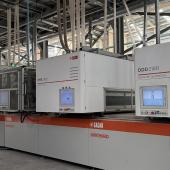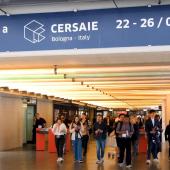"The Future of Ceramics". Acimac conference focuses on digitalisation and new market challenges
40 Italian and international speakers and guests, 14 hours of conferences and 6 roundtable discussions taking stock of the prospects for ceramic tiles in the main international markets and the evolution of factories in the age of digitalisation.
The ceramic industry is moving fast towards complete digitalisation of its production lines and is increasingly adopting a genuinely global vision. These were the key aspects that emerged from The Future of Ceramics, the two-day International Business Forum organised in Modena on 11 and 12 November by Acimac and Italian Exhibition Group - Tecnargilla in collaboration with the magazine Ceramic World Review.
The Forum was attended by more than 500 professionals and focused on two main theme areas: scenarios and prospects for the ceramic industry in the main international markets and the evolution of factories in the age of digitalisation. Talks given by around 40 Italian and international speakers and guests contributed to the diffusion of technical and managerial expertise in keeping with a systemic approach and a global ceramic supply chain vision.
A global outlook. The thought-provoking opening presentation given by Luca Baraldi from the Acimac Research Department gave an overview of the changes that have occurred in the world manufacturing industry over the last 20 years, including a steady shift in the centre of gravity of the industry towards Asia and the recent emergence of Africa as a producer country. Moreover, while global exports have tripled in the space of 20 years, they have remained stable at 21% of total production and just 8 tiles out of every 100 produced are exported outside the continent of production.
Major changes in the US market. Amongst the international speakers, Joseph Lundgren (JLConsulting, USA) discussed the recent decision by the US Department of Commerce to introduce antidumping duties (up to 356%) on imports of Chinese ceramic tiles (60 million sq.m in 2018), a measure that may have major consequences for competition between the other exporter countries to the US market.
New prospects for Asia and Africa. Five leading figures were invited to discuss the changes underway in Asia and Africa: Ye Yongkai (Vice President of New Pearl Ceramics, China’s largest tile producer), Prem Narayan Trivedi (Indian Council of Ceramic Tiles & Sanitaryware), Patrick Oaikhinan (Epina Technology, Nigeria), Mohammad Roshanfekr (Chairman of the Iranian Ceramic Producers’ Syndicate) and Ilter Yurtbay (Chairman of the Turkish ceramic tile producers’ association Serkap). While the Chinese businessman confirmed the slowdown of the local ceramic industry, determined amongst other things by the increase in duties in various export markets and the raising of environmental standards by the government and the consequent closure of dozens of factories, Trivedi reaffirmed the Indian industry’s intention to continue to expand in both the domestic and export markets. Major development programmes have also been confirmed in Iran, where 50% of the ceramic tile companies are planning plant modernisation and new factories are about to be opened in the Yazd district. Turkey is likewise looking to expand into new markets as the only tool now available for driving the recovery of the sector. Finally, Nigeria is set to continue the development of its fledgling ceramic industry, almost entirely owned by Chinese investors. It has already become Africa’s second largest producer country and is in need of collaboration, particularly in the training of technicians.
Challenges and opportunities in Europe. A popular keynote speaker, Christophe Callon (marketing and purchasing director at Saint Gobain Building Distribution) focused on the European flooring market, where the advance of vinyl materials will force the ceramic tile industry to identify new competitive strategies including logistics and training.
The themes addressed by the French manager were taken up again in the subsequent roundtable discussion between the chairmen of the three trade associations making up the Italian ceramic industry’s supply chain: Giovanni Savorani (Confindustria Ceramica), Paolo Sassi (Acimac) and Claudio Casolari (Ceramicolor).
The Digital Future of Ceramics.
The session on the digitalisation of ceramic companies began with a talk by Franco Stefani in a live link from Shanghai, followed by thought-provoking presentations given by Marco Calabrò (Ministry for Economic Development), Valentina Carlini (Confindustria), Maurizio Brioschi (Cefriel) and Luciano Sottile (Goglio).
Digital Evolution.
The audience showed keen interest in the technological focus sessions held during the 11th Acimac Annual Meeting, where suppliers and ceramic producers unanimously agreed that it is now essential to continue the journey towards complete digitalisation and the smart factory. It is a goal that must be achieved in the shortest possible time and will require a great deal of work and commitment from all players in the supply chain, they added.
Representatives of leading suppliers and producers discussed the digitalisation of ceramic companies, warehouses and intralogistics 4.0, as well as digital decoration of ceramic surfaces. In three different roundtable discussions, speakers from BMR, LB, Metco, Movetro/ Intermac, Plannet, Proteo, Sacmi, Sicer, System Ceramics, Toyota Material Handling and Weflex exchanged views with Maurizio Mambelli (Florim), Giulia Catti and Matteo Bondavalli (Mariner), Roberto Fornaciari (Labocer), Luca Costi (Del Conca), Gianpaolo Capitanio (Casalgrande Padana), Gilberto Pedna (ABK), Alessandro Barbieri (Italgraniti) and Eugenio Belli (Kerbell).
The slides of the November 12th session will be published in this website on Novembre 25th.
Did you find this article useful?
Join the CWW community to receive the most important news from the global ceramic industry every two weeks









































